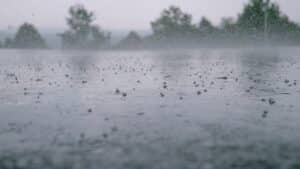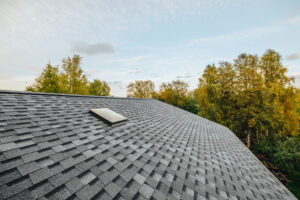Spring in Maryland can bring beautiful weather—but also powerful storms. High winds, heavy rain, hail, and falling branches can all take a toll on your roof. The trouble is, roof damage isn’t always obvious until it becomes a major (and expensive) problem.
At Platinum Exteriors, we help homeowners spot and repair roof damage early to protect their homes and avoid costly repairs. Here’s what to look for after a spring storm—and when to call in the pros.

Inspect Shingles for Missing or Damaged Sections
One of the most common signs of storm damage is missing, cracked, or curled shingles. After a storm passes, do a ground-level visual inspection. If you see bare patches or shingles that look out of place, it’s time to have a professional take a closer look.
Keep an eye out for:
- Shingles lying in your yard
- Bent or lifted shingle edges
- Dark spots where granules have worn away
Look for Granule Loss
Asphalt shingles are coated with tiny granules that protect them from UV rays and water damage. After heavy rain or hail, you might notice these granules collecting in your gutters or downspouts. Significant granule loss means your shingles are wearing down and could soon start leaking.
Check for Dents and Dings
Hail can leave small dents or cracks not only in shingles but also in metal roof components like flashing, vents, and gutters. These dents might seem minor but can lead to leaks over time if not addressed.
If you spot any signs of impact damage—or if you heard hail during the storm—it’s a good idea to schedule a professional inspection.
Examine the Attic and Ceilings for Leaks
Sometimes, roof damage shows up inside your home first. After a storm, check your attic and upper ceilings for:
- Water stains or discoloration
- Damp insulation
- Dripping water or puddles
Even small leaks can quickly lead to mold growth and structural damage if left untreated.
Don’t Forget the Flashing and Gutters
Flashing (the metal strips around chimneys, vents, and roof edges) is essential for keeping water out. Storms can loosen or warp flashing, leading to leaks.
Also, inspect your gutters and downspouts for blockages or damage. Clogged or broken gutters can cause water to back up onto the roof, increasing the risk of leaks and wood rot.
When in Doubt, Call the Experts
Not all roof damage is easy to see from the ground—or to recognize without training. That’s why professional inspections are essential after major storms. At Platinum Exteriors, our roofing experts can identify hidden damage, recommend the best repair options, and help you navigate any insurance claims if needed.
Protect Your Home with Platinum Exteriors
Your roof is your home’s first line of defense against the elements. After spring storms, a quick inspection can prevent small issues from turning into costly repairs.
Think your roof may have suffered storm damage? Contact Platinum Exteriors today for a thorough inspection and expert repair solutions.




